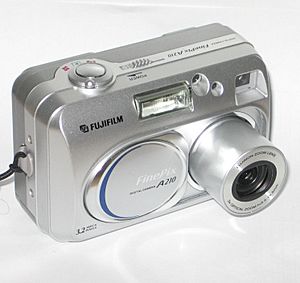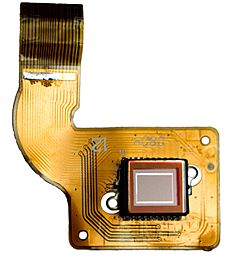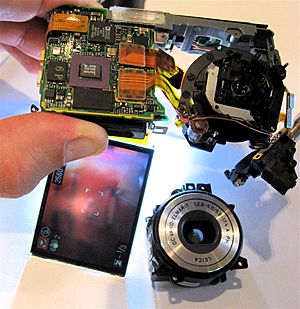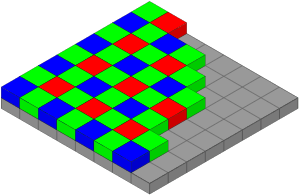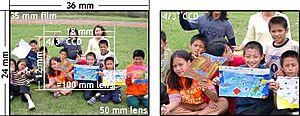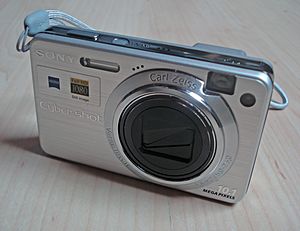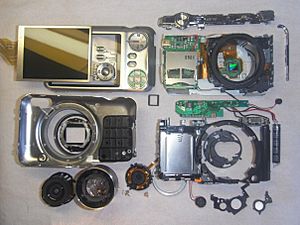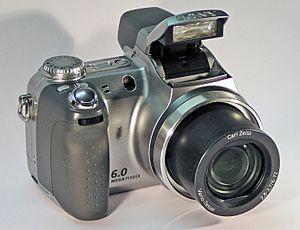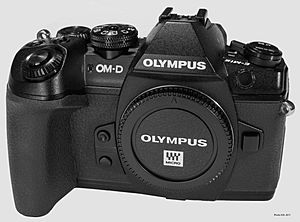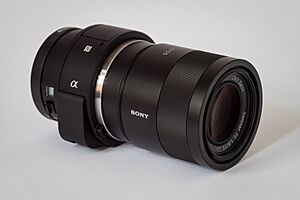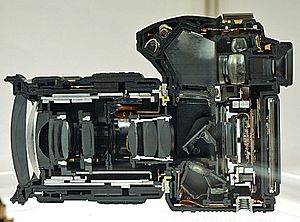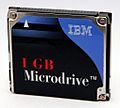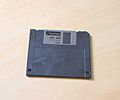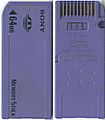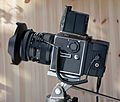Digital camera facts for kids
A digital camera is a special kind of camera that saves pictures in electronic memory instead of using film. This means a digital camera can hold many more pictures than an old film camera, sometimes hundreds or even thousands! Most digital cameras use a small memory card to store these photos. You can usually connect your digital camera to a computer with a USB cable to easily move your pictures.
Digital photography is simply taking photos using a digital camera. Instead of film, digital cameras use a special part called an image sensor. They store photos as digital files, often on a memory card. Today, most photos are taken digitally, even though some photographers still enjoy using film cameras.
Many cameras are now built into mobile phones, which are often called "camera phones." These phones can send pictures to other phones or devices. Usually, separate cameras take better pictures than camera phones, especially when there isn't much light. Most digital cameras can also record videos. Some can even send their data directly to a computer for storage.
Contents
History of Digital Cameras
The idea for digital cameras started long ago. In 1961, Eugene F. Lally from the Jet Propulsion Laboratory thought about using a special sensor to capture digital images. He imagined taking pictures of planets and stars in space to help astronauts know where they were. But the technology wasn't ready yet!
Then, in 1975, an engineer named Steven Sasson at Eastman Kodak invented and built the very first electronic camera. It used a special part called a charge-coupled device (CCD) to capture images. At first, these cameras were mostly used for military and science, then for medicine and news.
In 1986, the Japanese company Nikon introduced the first digital single-lens reflex (DSLR) camera, called the Nikon SVC. By the mid-1990s, DSLR cameras became popular with regular people. By the mid-2000s, they had mostly replaced old film cameras.
In 2000, Sharp launched the world's first digital camera phone, the J-SH04 J-Phone, in Japan. By the mid-2000s, many cell phones had a built-in digital camera. By the early 2010s, almost all smartphones came with a digital camera.
How Digital Cameras See Images
Digital cameras use special parts called image sensors to turn light into digital information. The two main types are CCD and CMOS. A CCD sensor has one main amplifier for all its tiny light-detecting spots (pixels), while a CMOS sensor has a small amplifier for each pixel. CMOS sensors use less power than CCDs. The final quality of a picture depends more on how the camera processes the image than on the type of sensor.
Picture Quality and Pixels
The resolution of a digital camera is how much detail it can capture. This is often limited by the image sensor. The brighter a spot on the sensor, the higher the value it records for that tiny spot, called a pixel.
The number of pixels on the sensor tells you the camera's "pixel count." For example, a sensor with 1,000 pixels across and 1,000 pixels down would have 1,000,000 pixels, or 1 megapixel. More megapixels usually mean more detail in your photos.
Image Sharpness
The final quality of an image depends on all the parts that create it. Think of it like a chain: the weakest link determines how strong the whole chain is. For a digital camera, the lens usually decides how sharp the image can be, while the sensor decides how much detail (resolution) it can capture. The pictures on the right show how a blurry lens can make a high-resolution image look bad, compared to a sharp lens on a lower-resolution camera.
How Cameras Capture Color
Most digital cameras use a special filter called a Bayer filter mosaic. This filter has tiny red, green, and blue squares over the pixels. Each pixel only "sees" one color. The camera then uses a process called "demosaicing" to guess the other two colors for each pixel, creating a full-color image.
The Bayer filter pattern is a repeating pattern of green, red, and blue filters. There are more green filters because human eyes are more sensitive to green light and use it most for brightness. The camera's software then fills in the missing color information for each pixel by looking at the colors of nearby pixels.
Sensor Size and View
Digital cameras have different sensor sizes. A smaller sensor will "crop" the view of the lens, making it seem like the lens has a longer focal length. This is called the crop factor. For example, a camera with a 1.5x crop factor will make a 50mm lens look like a 75mm lens (50 x 1.5 = 75) on a traditional 35mm film camera. Cameras with larger sensors, like Full-frame digital SLRs, have a sensor the same size as 35mm film, so there's no crop factor.
Larger sensors generally perform better in low light and can create a shallower depth of field, which means the background can be more blurry.
Types of Digital Cameras
Digital cameras come in many shapes, sizes, and with different features. Besides regular cameras, there are also special ones for science, medicine, and other uses.
Compact Cameras
Compact cameras are small and easy to carry, often fitting in a pocket. They are great for quick "snapshots."
Many compact cameras have a lens that retracts (pulls back) into the camera body, and a cover that protects the lens. Most are designed to be easy to use and have an "auto mode" that sets everything for you. Some also let you control settings manually.
Compact cameras usually have small sensors, which makes them compact but can affect picture quality in low light. They typically save images as JPEG files. Most have a small built-in flash for close subjects. They almost always use an LCD screen to show you what you're taking a picture of. Besides photos, most compact cameras can also record videos.
These cameras often have macro mode for close-up shots and zoom lenses. Some high-end compact cameras have many advanced features like GPS, Wi-Fi, and can even shoot in RAW format.
Rugged Compacts
Rugged compact cameras are built to be tough! They are protected against water, cold, heat, drops, and pressure. You might see them called waterproof, freezeproof, shockproof, or crushproof. Many major camera brands make these. Some can go deep underwater, while others are only splash-proof. They often record video and sound, and most have image stabilization and a built-in flash.
Action Cameras
Brands like GoPro make action cameras. These are tough, small cameras that you can easily attach to a helmet, arm, or bicycle. Most have a wide-angle lens and fixed focus. They can take both still pictures and video, usually with sound. Action cameras are very popular for sharing adventures on social media.
360-degree Cameras
A 360-degree camera can take pictures or videos all around you, using two lenses that shoot at the same time. Some popular ones are the Ricoh Theta S and Nikon Keymission 360. These cameras are great for virtual reality and can often stream live video. Some are even water-resistant, so you can use them as action cameras.
Bridge Cameras
Bridge cameras look a lot like DSLRs but are simpler inside. They have a fixed lens and a small sensor, like compact cameras. They often use an electronic viewfinder (EVF) or the main screen to frame your shot.
Because of their larger size and small sensor, bridge cameras can have amazing superzoom lenses and wide apertures. They usually have image stabilization to help with blurry photos, especially in low light. Many can save images in RAW format, not just JPEG. Bridge cameras are more portable and often cheaper than DSLRs, making them good for outdoor activities if you don't need professional-level photos.
Mirrorless Interchangeable-Lens Cameras (MILC)
Starting in 2008, a new type of camera appeared: mirrorless interchangeable-lens cameras (MILC). These cameras are simpler and smaller than DSLRs because they don't have a mirror system. You can change lenses on MILC cameras, and they come with various sensor sizes. A downside of MILC cameras compared to DSLRs is that their electronic viewfinders can use more battery power.
Modular Cameras
Modular cameras are special because the camera's sensor and shutter are built into the lens itself. Some of these are "lens-style cameras" that attach to your smartphone. They have all the camera parts but no screen or controls. Instead, they use your smartphone's screen and controls! Examples include the Sony SmartShot QX series and the Olympus Air.
Digital Single-Lens Reflex (DSLR) Cameras
Digital single-lens reflex cameras (DSLRs) use a special mirror that moves. When you look through the viewfinder, the mirror reflects light from the lens up to your eye. When you press the shutter button, the mirror quickly flips up, letting the light hit the sensor to take the picture. This is why the viewfinder goes dark for a moment when you take a photo.
DSLRs have much larger sensors than other camera types, which means they can capture more light. This helps them take great pictures in low light. They also use interchangeable lenses, so you can choose the best lens for different types of photography.
Digital Single Lens Translucent (DSLT) Cameras
A DSLT camera uses a fixed translucent (see-through) mirror instead of a moving one like in DSLRs. This mirror reflects some light to the viewfinder and lets some light pass through to the sensor at the same time. This means the viewfinder never goes dark when you take a picture. A big advantage of DSLT cameras is that they can keep focusing continuously, which is great for taking fast action shots or videos. So far, only Sony has released DSLT cameras.
Line-Scan Camera Systems
Line-scan cameras are different because they only have a single row of pixels, not a grid. They continuously scan an object or scene, and a computer puts these lines together to create an image. These cameras are often used in factories to inspect products moving quickly, or for photo finishes in races to see who crossed the finish line first. They are also used in scanners and satellites.
Stand-Alone Cameras
Some cameras are designed to be used remotely, without a screen or viewfinder. You control them with a phone app. They are often small, waterproof, and can take photos and videos.
Cameras in Other Devices
Many devices have cameras built-in, like smartphones, mobile phones, and laptops. These built-in cameras usually save pictures as JPEG files.
Camera phones became very popular. In 2003, more camera phones were sold than stand-alone digital cameras. By 2006, they even outsold both film and digital stand-alone cameras!
Connecting Your Camera
Transferring Photos
Most digital cameras can connect directly to a computer to move pictures.
- Older cameras used a PC serial port, but now USB is the most common way. Many cameras act like a USB storage device, so you can just drag and drop files.
- Some cameras use wireless connections like Bluetooth or Wi-Fi. You can also get Wi-Fi memory cards that send pictures to your computer or smartphone.
- Camera phones and some advanced cameras can use cellular networks to share images, often through MMS ("picture messaging") or by sending photos as email attachments.
A common way to transfer photos is using a card reader. This device plugs into your computer and can read different types of memory cards. It's often faster and saves your camera's battery. Many computers even have a card reader built-in.
Printing Photos
Many modern cameras support PictBridge. This allows them to connect directly to a PictBridge-compatible computer printer to print photos without needing a computer. Wireless connections can also be used for printing.
An instant-print camera is a digital camera with a printer built right in. It's like the old instant cameras that printed photos right away, but it uses digital technology.
Displaying Photos
Most digital cameras have a video output port, usually sVideo, to connect to a television. This lets you view your pictures on a TV screen, either one by one or as a "slide show." Newer cameras often have an HDMI port to show photos in high quality on an HDTV.
Some DVD recorders and TVs can read memory cards directly from cameras.
Weather Protection
Some cameras are built to handle different weather conditions. They can be sealed to protect against splashes, moisture (like fog), dust, and sand. Some are even completely waterproof, allowing for underwater photography down to a certain depth. Many waterproof cameras are also shockproof and can work in cold temperatures.
Camera Modes
Many digital cameras have special modes for different situations. These modes automatically adjust settings like exposure, aperture, focus, white balance, and sensitivity. For example, a "portrait" mode might use a wider aperture to blur the background and focus on a person's face.
Storing Your Photos

Most camera phones and stand-alone digital cameras save pictures on flash memory cards or other removable media. SD cards are the most common, but some cameras use CompactFlash or other types. Some high-end cameras even have two memory card slots.
A few older cameras used other types of storage like tiny hard disk drives called Microdrives, small CD singles, or even 3.5" floppy disks.
-
Microdrive (CF-II)
-
Sony's Memory Stick
File Formats
The most common file format for digital photos is JPEG. Other formats include TIFF and various Raw formats.
Many cameras, especially professional ones, can save pictures in a raw image format. A raw image is the unprocessed data directly from the camera's sensor. It's like a digital negative that gives you more control when editing the picture later without losing quality.
For videos, common formats include AVI, MPEG, MOV, and MP4. MP4 is popular because it uses newer compression to allow longer recording times.
Most cameras also add Exif data to your pictures. This is like a digital tag that includes information about the photo, such as the aperture, exposure time, focal length, and when and where the picture was taken.
Batteries
Digital cameras have become smaller, so batteries also need to be small but powerful enough to keep the camera working for a good amount of time. Most modern cameras use special rechargeable lithium-ion batteries. Some cameras can also use standard AA batteries.
Images for kids
-
A USB flash drive, used for storing digital files.
-
Old 3.5" floppy disks, once used for storing computer data.
-
Sony's special Memory Stick cards.
See also
 In Spanish: Cámara digital para niños
In Spanish: Cámara digital para niños


